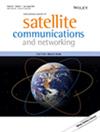Evaluation of multi‐user multiple‐input multiple‐output digital beamforming algorithms in B5G/6G low Earth orbit satellite systems
IF 1.6
4区 计算机科学
Q3 ENGINEERING, AEROSPACE
International Journal of Satellite Communications and Networking
Pub Date : 2023-08-14
DOI:10.1002/sat.1493
引用次数: 0
Abstract
Satellite communication systems will be a key component of 5G and 6G networks to achieve the goal of providing unlimited and ubiquitous communications and deploying smart and sustainable networks. To meet the ever‐increasing demand for higher throughput in 5G and beyond, aggressive frequency reuse schemes (i.e., full frequency reuse), combined with digital beamforming techniques to cope with the massive co‐channel interference, are recognized as a key solution. Aimed at (i) eliminating the joint optimization problem among the beamforming vectors of all users, (ii) splitting it into distinct ones, and (iii) finding a closed‐form solution, we propose a beamforming algorithm based on maximizing the users' signal‐to‐leakage‐and‐noise ratio served by a low Earth orbit satellite. We investigate and assess the performance of several beamforming algorithms, including both those based on channel state information at the transmitter, that is, minimum mean square error and zero forcing, and those only requiring the users' locations, that is, switchable multi‐beam. Through a detailed numerical analysis, we provide a thorough comparison of the performance in terms of per‐user achievable spectral efficiency of the aforementioned beamforming schemes, and we show that the proposed signal to‐leakage‐plus‐noise ratio beamforming technique is able to outperform both minimum mean square error and multi‐beam schemes in the presented satellite communication scenario.B5G/6G近地轨道卫星系统中多用户多输入多输出数字波束形成算法的评估
卫星通信系统将是5G和6G网络的关键组成部分,以实现提供无限和无处不在的通信以及部署智能和可持续网络的目标。为了满足5G及以后对更高吞吐量不断增长的需求,积极的频率复用方案(即全频率复用)与数字波束形成技术相结合,以应对大规模的同信道干扰,被认为是一个关键解决方案。为了(i)消除所有用户波束成形矢量之间的联合优化问题,(ii)将其拆分为不同的波束成形矢量,以及(iii)找到一个闭合形式的解决方案,我们提出了一种基于最大化近地轨道卫星服务的用户信噪比的波束成形算法。我们研究并评估了几种波束成形算法的性能,包括基于发射机信道状态信息的波束成形算法,即最小均方误差和迫零算法,以及只需要用户位置的波束成形方法,即可切换多波束算法。通过详细的数值分析,我们对上述波束成形方案在每个用户可实现的频谱效率方面的性能进行了彻底的比较,并且我们表明,在所提出的卫星通信场景中,所提出的信噪比波束形成技术能够优于最小均方误差和多波束方案。
本文章由计算机程序翻译,如有差异,请以英文原文为准。
求助全文
约1分钟内获得全文
求助全文
来源期刊
CiteScore
4.10
自引率
5.90%
发文量
31
审稿时长
>12 weeks
期刊介绍:
The journal covers all aspects of the theory, practice and operation of satellite systems and networks. Papers must address some aspect of satellite systems or their applications. Topics covered include:
-Satellite communication and broadcast systems-
Satellite navigation and positioning systems-
Satellite networks and networking-
Hybrid systems-
Equipment-earth stations/terminals, payloads, launchers and components-
Description of new systems, operations and trials-
Planning and operations-
Performance analysis-
Interoperability-
Propagation and interference-
Enabling technologies-coding/modulation/signal processing, etc.-
Mobile/Broadcast/Navigation/fixed services-
Service provision, marketing, economics and business aspects-
Standards and regulation-
Network protocols

 求助内容:
求助内容: 应助结果提醒方式:
应助结果提醒方式:


